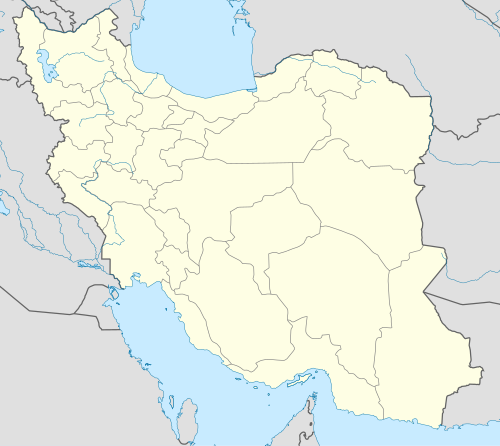Masuleh
City in Gilan province, Iran From Wikipedia, the free encyclopedia
Masuleh (Persian: ماسوله; ⓘ)[a] is a city in Sardar-e Jangal District of Fuman County, Gilan province, Iran.
This article needs additional citations for verification. (February 2023) |
Masuleh
Persian: ماسوله | |
|---|---|
City | |
 Masuleh view | |
| Coordinates: 37°09′18″N 48°59′22″E / 37.15500; 48.98944][[Category:Pages using gadget WikiMiniAtlas]]"},"html":"Coordinates: </templatestyles>\"}' data-mw='{\"name\":\"templatestyles\",\"attrs\":{\"src\":\"Module:Coordinates/styles.css\"},\"body\":{\"extsrc\":\"\"}}'/>37°09′18″N 48°59′22″E / 37.15500°N 48.98944°E"}">[1] | |
| Country | Iran |
| Province | Gilan |
| District | Sardar-e Jangal |
| Population (2016)[2] | |
• Total | 393 |
| Time zone | UTC+3:30 (IRST) |
Masuleh is approximately 60 km southwest of Rasht and 32 km west of Fuman. Its people are Talysh. The village is 1,050 meters above sea level in the Alborz mountain range, near the southern coast of the Caspian Sea. The village itself has a difference in elevation of 100 meters.
Although some say the community was established around 10 AD, Old Masuleh dates to 1006 AD, 6 km northwest of the current city (Kohneh Masuleh in Persian). People moved from Old Masuleh to the new site because of pestilence and attacks from neighbouring communities.
Demographics
Language
The native people of Masuleh are Gilak and Talysh, they speak Talysh.[citation needed]
Population
At the time of the 2006 National Census, the city's population was 554 in 180 households.[4] The following census in 2011 counted 568 people in 210 households.[5] The 2016 census measured the population of the city as 393 people in 147 households.[2]
Climate
| Climate data for Masuleh (37.15°N 48.983°E, 2006-2015 precipitation normals) | |||||||||||||
|---|---|---|---|---|---|---|---|---|---|---|---|---|---|
| Month | Jan | Feb | Mar | Apr | May | Jun | Jul | Aug | Sep | Oct | Nov | Dec | Year |
| Average precipitation mm (inches) | 73.2 (2.88) |
79.9 (3.15) |
95.3 (3.75) |
102.1 (4.02) |
61.4 (2.42) |
39.1 (1.54) |
50.1 (1.97) |
48.7 (1.92) |
83.9 (3.30) |
110.3 (4.34) |
113.1 (4.45) |
83.4 (3.28) |
940.5 (37.02) |
| Source: IRIMO[6] | |||||||||||||
Architecture
Summarize
Perspective
Buildings are mostly two stories (1st floor and 'ground' floor), although there are three-story and four-story houses as well.
There are four main local communities at the city named: "Maza-var" (meaning beside the Mosque) at the south, "Khana-var" (beside homes) at the East, "Kasha-sar" (stretched on top) at the North, and, "Assa-mahala" (Assad community) at the West. Apparently, down town is the Market (Bazaar) area and also the main mosque of the city, named "O-ne-ben-ne Ali" (Awn Ibn Mohammad Ibn Ali Ibn. Abi Taleb) built in 969 AD.[7]
In some of these houses, it has been possible to live in separate apartments in different periods. For example, the Zandipour House, which is now used as an apartment hotel, was accommodated by different families who lived in their separate apartment units for a long time. Each of these units had a separate bathroom and different families lived separately in each of the three floors. However, some three-story houses were occupied by an extended family as the children who were married lived together with their parents in a class structural house.
Girih tiling in buildings of Masuleh

Girih tiling consists of straight and broken lines on a regular basis that could be reasonably expanded in the surface.[8]
The historical city of Masuleh is a good model for sustainable architecture and its final aim is respecting the culture and friendly relationship with nature and improving the life style of its residents.[9]
Archaeology
The earliest evidence of human presence in the Masouleh region, Iran, is a Levallois core from the Middle Paleolithic, likely made by Neanderthals over 40,000 years ago. This highlights Neanderthal activity in the area.[10] Archaeological survey of the mountain ranges overlooking Masouleh shows that this mountainous region was probably occupied by ancient herders and nomads at least since the late Bronze Age.[11]
Remains of late prehistoric, historic, and Islamic times were discovered on the mountain top above 2500 meters above sea level(See). These mountains were used seasonally, at least since the late Neolithic (5000 BC) Bronze Age (2000-1500 BC), which continued during the Iron Age I (1500-1100 BC), Iron Age III (800-500 BC), Parthian (247 BC to 224 CE), Buyid (943–1029 CE), Seljuk (1043–1051 CE) and Ilkhanid (1306–1335 CE) eras (tehrantimes).
Archaeologists discovered pottery sherds, animal bones, and stone tools that date back to about 7,000 years ago. [12]
Tourism areas
Waterfalls: Kooshm, Larcheshme, and Kourbar.[13]
Gallery
- Window of building in Masuleh
- The yard of the above building is the roof of the below building
- The nature of Masuleh
- Buildings are mostly 2 stories
See also
Media related to Masuleh at Wikimedia Commons
Notes
- Also romanized as Masouleh and Māsūleh; also known as Masoleh;[3] historical names for the city include Khortāb and Māsalar[citation needed]
References
External links
Wikiwand - on
Seamless Wikipedia browsing. On steroids.





